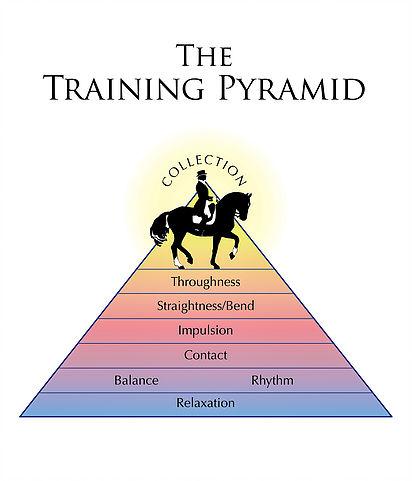
Chakras & the Training Pyramid: Part 2
Balance, rhythm and the sacral chakra.
Last week, we discussed the connections between the first level of the training pyramid, relaxation, and the base chakra.

This illustration first appeared in the November 1997 issue of Dressage Today magazine (DressageToday.com). Used here with permission.
This week, let’s talk about balance, rhythm, and the sacral chakra.
The sacral chakra, the second of the seven chakras, is located about two inches below the navel of most humans, just above the pelvic bowl (the location of the root chakra). The sacral chakra is the center for trust, emotions, and motivations. As most of us riders have experienced at some point in our riding careers, tension in the hip area can impede our riding.
Such tension, relative to chakras, is due to the sacral chakra being closed. Emotional tension also resides here; have you ever felt fear and had your gut tighten up in physical response to the fear? That is the sacral chakra closing.
Closing the sacral chakra means we are neither balance nor rhythmic riders. Rather, we are stiff and disconnected from our horse — physically, mentally, and emotionally. If your horse feels tight, or behind the leg, he may be reflecting your own tightness in the sacral chakra.
One can open the sacral chakra in several ways. Dancing is a great way to keep this chakra open and flowing, and the more hip gyrations, the better! #ChannelYourInnerElvis

Yoga, especially positions that focus on opening up your hips, is also helpful for getting the sacral chakra flowing.
Perhaps one of the best things you can do to get your sacral chakra open and flowing, however, is to live in the moment. Let go. Release. When in the saddle, strive to focus on each stride instead of any thoughts that bring a sense of pressure to your mind. Learn to put negative thoughts on hold, so you don’t get obsessed by such negative, constricting thoughts such as what “could” go wrong, where you have to be after you finish riding, or anything else that tries to restrict your core.
Toning the muscles in your core actually helps open the flow of the sacral chakra. The firm, supportive core muscles provide a column of support through which the inner workings of this chakra can simply flow up to your head and, simultaneously, down through your horse. Want to ride like the great masters and “grow out of your horse” like a centaur? Have an open sacral chakra.
As an example to illustrate an extraordinarily open sacral chakra, below is a photo of adult amateur rider Dara Lindner. The horse is relaxed and listening, and Dara’s base chakra is open and deep in the saddle.
Once the horse is relaxed, it is time to help them become balanced and rhythmic in their movements. Note Dara’s open and rotating hips, as evidenced by the forward roll of her hips under her beltline. This is the sacral chakra area, and Dara is following her riding partner’s movements easily because her hips are naturally so open – they can literally flow with the horse’s movement.
Also note her open hands, which further release the sacral area so the entire body of the horse can flow forward along his spine from tail to nose. This openness allows the horse to be balanced; note the very small displacement of the arena surface, despite the horse’s full weight on the outside hind, as well as the vertical symmetry of the three airborne hoofs and the horizontal symmetry between the shoulders and hips – these elements disclose a training level horse in a balanced frame, traveling in a steady, rhythmic canter.
As equestrians and athletes, we tone our core to support our upper body, yet we need to maintain an inner, open relaxation throughout the core, so the sacral chakra can be open and flowing. This allows us to flow with the forward movement of our riding partner, which, in turn, allows our riding partner to move in a balanced and rhythmic way with every stride and, especially, during transitions.
This is why it is so important to not “tense up” during a transition, but, rather, relax, breathe deep, and utilize minimal, specific muscle groups when giving the half-halt to communicate the upcoming change to the horse. Keep the sacral chakra open and allow the horse to flow forward all the time, whether forward flowing into an upward (faster) gait or even flowing forward to the halt. This openness and forward flow will help keep your horse from jolting through a transition, dropping into a transition, or sucking back and having to be driven to the transition.
By allowing the sacral chakra to be always open, the horse’s body can flow forward in every moment of movement, and this creates true balance and allows your horse to maintain a steady rhythm.







Leave a Comment